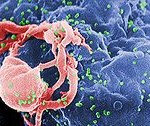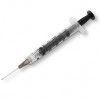HIV Vaccine?
We are in the midst of a media explosion surrounding the possibility of a vaccine for HIV. For years this has seemed a hopeless situation, so a great deal of effort and money has been spent on the campaign to educate people about transmission and prevent infection. Unfortunately, according to recent reports (http://www.mg.co.za/article/2010-07-12-hiv-vaccine-the-only-real-answer), the number of new infections is still an alarming 7400 per day! In addition, less than half of the 9.5 million people in low-middle income households infected with HIV have access to anti viral treatments.
These staggering statistics demonstrate very clearly that efforts to help infected individuals are available and do reach millions, but they just aren’t enough. Development of a vaccine, probably the best method of prevention, has been an extremely slow process. Students ask about this all the time. If scientists can eradicate small pox, if they can make a new flu-shot every year, then why can’t they make a vaccine for HIV? The virus mutates so quickly that once infected, the host harbors any number of viral variants, all unique!
Interestingly enough, one in four patients infected with HIV carry two very strong anti-HIV antibodies that seem to neutralize 91% of HIV strains (http://www.webmd.com/hiv-aids/news/20100709/antibodies-discovery-may-pave-way-to-aids-vaccine ). Why don’t they work? They usually aren’t produced until the infection is rampant, and by the time they are produced, the virus has begun to mutate! So, the thought process is this: if individuals were given a vaccine that elicited the production of these antibodies before exposure to the virus, they would likely prevent infection upon exposure. The key now is development of the vaccine, and then dissemination to regions in need.
The identification and isolation of these antibodies have shed some light on what seemed to be an almost hopeless situation. I look forward to the next five years of research in this field and believe that there will be a vaccine in the next 10.
| Print article | This entry was posted by Amanda McBrien on July 14, 2010 at 11:48 am, and is filed under DNA From The Beginning. Follow any responses to this post through RSS 2.0. You can skip to the end and leave a response. Pinging is currently not allowed. |



